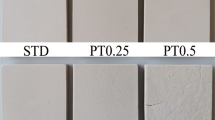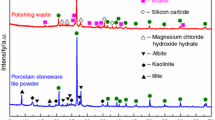Abstract
In recent years, porcelain tiles have been increasingly used as an alternative to natural stone and marble. Moreover, the expectation of the development of more white porcelain tile bodies is also increasing. The aim of the present study is to develop ultra-white porcelain tile compositions which have significantly higher whiteness value (L* > 90) than the standard super-white porcelain tile composition because of diopside and anorthite crystallization during sintering. For this purpose, a frit which is crystallizing to diopside was used in the new composition in the present studies. Firing shrinkage, water absorption and color values (L*, a, b) of the compositions were measured. Thermal expansion coefficient values of the bodies were determined by a dilatometer; the sintering behaviors were evaluated using a double-beam non-contact optical dilatometer (ODHT). The phase analyses of the fired bodies were achieved using XRD. Microstructural analyses were carried out with SEM. According to the results, ultra-white porcelain tile compositions which are suitable for production conditions could be developed. With an industrial perspective, the other important findings are that these compositions have lower firing shrinkage and lower thermal expansion coefficient than the standard porcelain tile formulation. This provides a wide working range in terms of pressing and production by preventing the deformation problems and reducing the risk of thermal shock.






Similar content being viewed by others
References
Menegazzo APM, Paschoal JOA, Andrade AM, Gouvea D, Carvalho JC. Evaluation of the technical properties of porcelain tile and granite. In: Qualicer; 2002. p. 211–30.
Sanchez E, Garcia-Ten J, Sanz V, Moreno A. Porcelain tile:almost 30 years of steady scientific-technological evolution. Ceram Int. 2010;36:831–45.
Ke S, Wang Y, Pan Z, Ning C, Zheng S. Recycling of polished tile waste as a main raw material in porcelain tiles. J Clean Prod. 2016;115:238–44.
Gültekin EE, Topates G, Kurama S. The effects of sintering temperature on phase and pore evolution in porcelain tiles. Ceram Int. 2017;43:11511–5.
Biffi G. Porcelain stoneware—production manual and methods of use. Faenza: Gruppo Editoriale Faenza Editrice S.p.A; 1999.
Carty WM, Senapati U. Porcelain—raw materials, processing, phase evolution, and mechanical behaviour. J Am Ceram Soc. 1998;81(1):3–20.
Worrall WE. Ceramic raw materials. Institute of Ceramics. 2nd ed. Leeds: Pergamon Press; 1982.
Vari A. Raw material preparation and forming of ceramic tiles. Modena: S.A.L.A; 2000.
Dondi M, Ercolani G, Melandri C, Mingazzini C, Marsigli M. The chemical composition of porcelain stoneware tiles and its influence on microstructural and mechanical properties. Interceram. 1999;48(2):75–83.
Parmelee CW. Ceramic glazes. Boston: Cahners Books; 1973.
Sainz IG. Physical–chemical characteristics of ceramic glazes and their influence on quality of floor and wall tiles. Tile Brick Int. 1990;6:21.
Taylor JR, Bull AC. Ceramics glaze technology. London: Pergamon Press; 1980. p. 111.
Santos CR, Fontana TLB, Uggioni E, Riella HG, Bernardin AM. Achieving opacity in ceramic tiles: micro structural and spectrophotometric analysis. In: Qualicer; 2004. p. 89–194.
Topates G, Tarhan B, Tarhan M. Chemical durability of zircon containing glass-ceramic glazes. Ceram Int. 2017;43:12333–7.
Taskiran MU, Demirkol N, Capoglu A. A new porcelainised stoneware material based on anorthite. J Eur Ceram Soc. 2005;25:293–300.
Gines F, Orenga A, Sheth A, Thiery D. Use of spodumene in fabricating technological porcelain tile bodies. In: Qualicer; 2004. p. 229–32.
Tucci A, Esposito L, Malmusi L, Rambaldi E. New body mixes for porcelain stoneware tiles with improved mechanical characteristics. J Eur Ceram Soc. 2007;27:1875–81.
Selli NT. Development of anorthite based white porcelain stoneware tile compositions. Ceram Int. 2015;41:7790–5.
Aparisi J, Sanchez LF, Amoros JL, Escardino A, Orts MJ, Mestre S. Obtaining smooth, white floor tile glazes from zirconium-free frits. In: Qualicer; 1998. p. 66–8.
Pekkan K, Karasu B. Zircon-free frits suitable for single fast-firing opaque wall tile glazes and their industrial productions. J Eur Ceram Soc. 2009;29:1571–8.
Applied ceramic technology. Sacmi Imola. Vol. 1, Italy. 2002. ISBN 88-88108-48-3.
Zanelli C, Raimodo M, Dondi M, Guarini G, Tenorio PM. Cavalcante, Sintering mechanisms of porcelain stoneware tiles. In: Qualicer; 2004. p. 247–59.
Boccaccini AR, Trusty PA. In situ characterization of the shrinkage behavior of ceramic powder compacts during sintering by using heating microscopy. Mater Charact. 1998;41(14):109–21.
Fan CL, Rahaman MN. Factors controlling the sintering of ceramic particulate composites I: conventional processing. J Am Ceram Soc. 1992;75:2056–65.
Boccaccini AR. Sintering of glass matrix composites containing Al2O3 platelet inclusions. J Mater Sci. 1994;29:4273–8.
Scherer GW. Viscous sintering of particle-filled composites. Ceram Bull. 1991;70:1059–63.
Andreola F, Siligardi C, Manfredini T, Carbonchi C. Rheological behaviour and mechanical properties of porcelain stoneware bodies containing Italian clay added with bentonites. Ceram Int. 2009;35:1159–64.
Manfredini T, Pellacani GC, Pozzi P. Preparation of a ceramic floor tile body containing pure bentonite as strengthening agent. Bol Soc Esp Ceram Vidr. 1991;30:5–9.
Pal M, Das S, Das SK. Anorthite porcelain: synthesis, phase and microstructural evolution. Bull Mater Sci. 2015;38(2):551–5.
Pal M, Das S, Gupta S, Das SK. Thermal analysis and vitrification behaviour of slag containing porcelain stoneware body. J Therm Anal Calorim. 2016;124(3):1169–77.
Viola C, Kovic BT. Vitrified stoneware or porcelain? Development and improvements in the ceramic technology of the high sintering flor tiles. Fine porcelain stoneware tiles technology, production, marketing. 1994.
Sanchez E, Orts MJ, Garcia-Ten K, Cantavella V. Porcelain tile composition effect on phase formation and end product. Am Ceram Soc Bull. 2001;80(6):43–9.
Tarhan B. Usage of fired wall tile wastes into fireclay sanitaryware products. J Aust Ceram Soc. 2019. https://doi.org/10.1007/s41779-018-0285-1.
Ozturk ZB. Microstructural characterization of mullite and anorthite-based porcelain tile using regional clay. J Ceram Process Res. 2015;17(6):555–9.
Ozturk ZB, Ay N. An investigation of the effect alkaline oxides on porcelain tiles using factorial design. J Ceram Process Res. 2012;13(5):635–40.
Tarhan B, Tarhan M, Aydın T. Reusing sanitaryware waste products in glazed porcelain tile production. Ceram Int. 2017;43(3):3107–12.
González-Miranda FM, Garzón E, Reca J. Thermal behaviour of sericite clays as precursors of mullite materials. J Therm Anal Calorim. 2018. https://doi.org/10.1007/s10973-018-7046-9.
Xian Z, Zeng L, Cheng X, Wang H. Effect of polishing waste additive on microstructure and foaming property of porcelain tile and kinetics of sinter-crystallization. J Therm Anal Calorim. 2015;122(2):997–1004.
Esposito L, Salem A, Tucci A, Gualtieri A, Jazayeri SH. The use of nepheline-syenite n a body bix for porcelain stoneware tiles. Ceram Int. 2005;31:233–40.
Kucuker AS. Milling efficiency in porcelain tile production and effects on production process. Ph.D. thesis, Anadolu University, Turkey. 2009.
Kingery WD, Bowen HK, Uhlmann DR. Introduction to ceramics. Hoboken: Wiley; 1976.
Aydın T, Tarhan M, Tarhan B. Addition of cement kiln dust in ceramic wall tile bodies. J Therm Anal Calorim. 2018. https://doi.org/10.1007/s10973-018-7615-y.
Acknowledgements
The author would like to thank Kaleseramik Çanakkale Kalebodur Seramik San. A.S. Canakkale, Turkey.
Author information
Authors and Affiliations
Corresponding author
Additional information
Publisher's Note
Springer Nature remains neutral with regard to jurisdictional claims in published maps and institutional affiliations.
Rights and permissions
About this article
Cite this article
Tarhan, M. Whiteness improvement of porcelain tiles incorporated with anorthite and diopside phases. J Therm Anal Calorim 138, 929–936 (2019). https://doi.org/10.1007/s10973-019-08268-8
Received:
Accepted:
Published:
Issue Date:
DOI: https://doi.org/10.1007/s10973-019-08268-8




